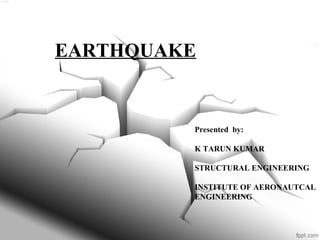
Earthquake Engineering
- 1. EARTHQUAKE Presented by: K TARUN KUMAR STRUCTURAL ENGINEERING INSTITUTE OF AERONAUTCAL ENGINEERING
- 2. Definition: • An Earthquake is a sudden and rapid shaking of the ground due to passage of vibrations beneath caused by transient disturbance of elastic or gravitational equilibrium of rocks. • The scientific study of earthquakes is called Seismology. • Earthquakes are measured using observations from seismometers. • Seismic waves are recorded on instruments called seismographs. • The time, locations, and magnitude of an earthquake can be determined from the data recorded by seismograph stations.
- 4. RICHTER MAGNITUDE SCALE: • The Richter magnitude scale was developed in 1935 by Charles F. Richter. • Earthquakes with magnitude of about 2.0 or less are usually called micro earthquakes; are generally recorded only on local seismographs. • Events with magnitudes of about 4.5 or greater, are strong enough to be recorded by sensitive seismographs all over the world. • Great earthquakes have magnitudes of 8.0 or higher. • On the average, one earthquake of such size occurs somewhere in the world each year.
- 6. CAUSES : Natural Causes of Earthquake: • Tectonic Movement • Volcanic Activity • Pressure of gases in the interior • Landslides and avalanches • Faulting and folding in the rock beds are responsible for causing minor earthquakes.
- 7. Man-made Earthquakes: • The impounding of large quantities of water behind dams disturbs the crustal balance. • The shock waves through rocks set up by the underground testing of Atom bombs or Hydrogen bombs may be severe to cause earthquake.
- 8. EFFECTS: Destructive Effects: • Earthquake causes dismantling of buildings, bridge and other structures at or near epicenter. • Rails are folded, underground wires broken. • Earthquakes originate sea waves called Tsunamis. • Earthquakes result in the formation of cracks and fissures on the ground formation. • The earthquakes cause landslides. • Landslide due to earthquake may block valleys to form lakes.
- 9. SEISMIC BELT: • Narrow geographic zone on the Earth's surface along which most earthquake activity occurs. • The outermost layer of the Earth (lithosphere) is made up of several large tectonic plates. There are three main seismic belts in the world : 1. Circum-Pacific seismic belt 2. Alpine-Himalayan seismic belt 3. Ridge seismic belt
- 12. SEISMIC WAVES: • Seismic waves are waves of energy that travel through the Earth's layers, and are a result of earthquakes, volcanic eruptions, magma movement, large landslides and large man-made explosions that give out low-frequency acoustic energy. • Seismic wave fields are recorded by a seismometer, hydrophone (in water), or accelerometer. P-waves: • P-waves are a type of body wave, that travel through a continuum and are the first waves from an earthquake to arrive at a seismograph. • Typical values for P-wave velocity in earthquakes are in the range 5 to 8 km/s.
- 13. S-WAVES: • S-waves, secondary waves, or shear waves (sometimes called an elastic S-wave) are a type of elastic wave. • The S-wave moves as a shear or transverse wave, so motion is perpendicular to the direction of wave propagation. •Velocity tends to increase with depth and ranges from approximately 2 to 8 km/s in the Earth's crust, up to 13 km/s in the deep mantle.
- 14. L-WAVES: • The third general type of earthquake wave is called a surface wave, reason being is that its motion is restricted to near the ground surface. • Such waves correspond to ripples of water that travel across a lake. • The typical range of velocities is between 2 and 6 km/second.
- 16. PRECAUTIONS: • First do the soil test. Structures will be constructed after testing the soils compaction tendency. • Design of the structures or buildings should be made by professional engineer. • Use rods according to the foundation type. • The rod must provide necessary earthquake resistance to the building or structure. • Maintain the quality of cement, rod and sand. Provide necessary rod in the joint of foundation and grade beam. • This helps to provide extra earthquake resistance to the structures or buildings. • Check column and slab design requirements by the authority.
- 17. • For earthquake resistance purposes, there will be no connection in the intersection of beam column. • Columns of the structures or buildings need to be made strong to provide needed resistance. Column size can be increased from the foundation necessarily.
- 22. LANDSLIDES: • A landslide is the movement of rock, debris or earth down a slope. • They result from the failure of the materials which make up the hill slope and are driven by the force of gravity. • Landslides are known also as landslips, slumps or slope failure. • This is the most destructive and turbulent form of landslide. Flows have a high water content which causes the slope material to lose cohesion, turning it into a slurry.
- 24. LANDSLIDES HAZARDS: • Although landslides are primarily associated with mountainous regions, they can also occur in areas of generally low relief. • In low-relief areas, landslides occur as cut-and fill failures (roadway and building excavations). • Slope saturation by water is a primary cause of landslides. This effect can occur in the form of intense rainfall, snowmelt, changes in ground-water levels.
- 25. Natural causes include: 1. Elevation of pore water pressure by saturation of slope material from either intense or prolonged rainfall and seepage 2. Vibrations caused by earthquakes 3. Undercutting of cliffs and banks by waves or river erosion 4. Volcanic eruptions Human causes include: 1. Removal of vegetation 2. Interference with, or changes to, natural drainage 3. Leaking pipes such as water and sewer reticulation 4. Modification of slopes by construction of roads, railways, buildings, etc
- 26. 5. Modification of slopes by construction of roads, railways, buildings, etc 6. Mining and quarrying activities
